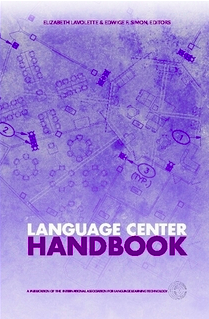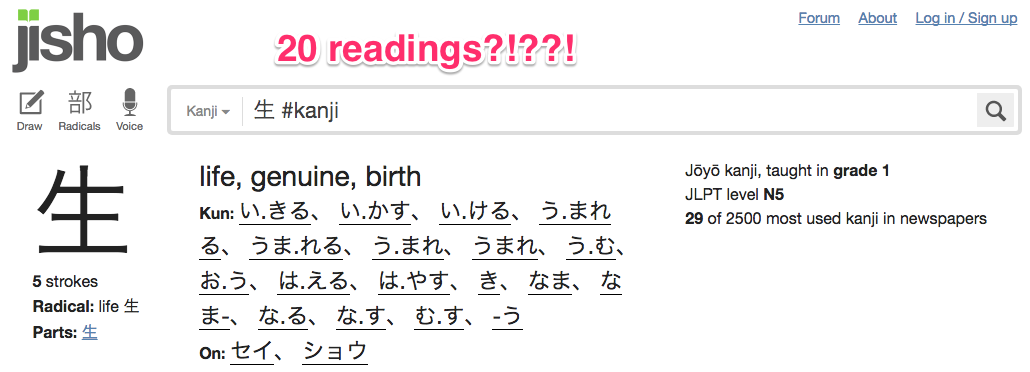Shiga JET Skills Development Conference Fall 2018
I am honored to have the opportunity to speak to current JET assistant language teachers (ALTs) in Shiga Prefecture at the Skills Development Conference on November 28, 2018.
Special thanks to all of the former ALTs who generously shared their experiences with me to help me prepare for this talk.
Keynote
Note that I removed some images from the slides because I don’t have permission to publish them.
Workshop
Kahoot (high-tech classroom)
Each student needs
- Device (smartphone, laptop, tablet) OR 1 device per team of 2-4 students
Teacher needs:
- Device to create
- Way to display (e.g., projector)
Tutorials:
Plickers (low-tech classroom)
Each student needs
Teacher needs
- Device to create (computer)
- Device to scan (smartphone, tablet)
- (Ideally) way to display (e.g., projector)
Tutorials
Announcing the Language Center Handbook

Proud to announce my first book as editor, with co-editor Edwige Simon!
The Language Center Handbook is an update to IALLT’s Language Center Management and Language Center Design volumes. The chapters cover topics related to language center management and design, including case studies from various contexts.
I also contributed a chapter about language center mandates, in which I report data from the 2015 IALLT Survey, and a short essay about the tenuous status of language centers.
Materials for Japanese, Chinese, and Spanish extensive reading
As I end my 3.5 years as Director of the Language Resource Center at Gettysburg College, I realized that there are some materials that I could be sharing. If you are thinking of starting an extensive reading club or incorporating extensive reading into your classroom teaching, I hope you’ll find these materials useful.
Japanese extensive reading resources
- List of rules in English and Japanese (PPTX)
- Reading logs for students to keep track of how much they have read (PDF for download)
- Template for a poster advertising your club (PPTX)
- A list of the Japanese books I collected for the club. (A few textbooks and reference books are also in the list–just ignore them!)
- More resources, including books for free download and purchase
Chinese extensive reading resources
- List of rules in English and Mandarin (PPTX)
- Reading logs for students to keep track of how much they have read (DOCX)
- Template for a poster advertising your club (PPTX)
- A list of the Chinese books I collected for the club. (A few textbooks and reference books are also in the list–just ignore them!)
Spanish extensive reading resources
- List of rules in English and Spanish (PPTX)
- Reading logs for students to keep track of how much they have read (DOCX)
- Template for a poster advertising your club (PPTX)
- A list of the Spanish books I collected for the club. (A few textbooks and reference books are also in the list–just ignore them!)
Teaching language with technology: Basic tools and techniques, 2017
Short link to this post: v.gd/clear17
I am honored to be invited to facilitate a workshop titled Teaching with technology: Basic tools and techniques, July 31-August 2, 2017. This is one of CLEAR‘s summer workshops, held at Michigan State University in East Lansing, MI.
I will facilitate learning to use the resources listed below during the workshop:
In-class response systems
- Socrative
- Cost: Free
- Platform: Web (including mobile)
- Description: Instructor creates multiple-choice, true-false, or short answer questions. Students respond using laptops or mobile devices. The instructor can display the results as they come in. You can let students respond anonymously or require students to enter their names. You can also use this system for in-class quizzes.
- Student login page (use to respond to questions during this workshop)
- Plickers
- Cost: Free
- Platform: iPhone, iPad, or Android (only 1 needed per classroom). The website is useful for creating classes, questions, and quizzes, but a mobile device is needed to scan students’ responses.
- Description: Students respond to multiple-choice and true-false questions using specially designed paper that they hold up. The teacher scans the room using a smart phone or tablet. The results can be instantly displayed.
- Getting started guide
- Plickers in 2 minutes (video)
- Help with Plickers
Digital storytelling
- General resources learning more about digital storytelling
- VoiceThread
- Cost: Free for up to 3 VoiceThreads; various pricing plans for more
- Platform: Web, iPhone, iPad, Android
- Example VoiceThread to try out commenting
- Another example to view
- Description: Upload a PowerPoint, PDF, video, images, etc., then record audio or video comments on each slide. The real power of VoiceThread is the ability to share and comment on other people’s work.
- More: VoiceThread and Universal Design for Learning
YouTube Video EditorCost: FreePlatform: Web, iPhone/iPad (limited functionality compared to web)Description: Upload video, then use YouTube’s editor to combine, split, and shorten clips and add a soundtrack, titles, and transitions.You need to be logged into your Google account to use this. The mobile app has more limited editing capabilities, but allows you to record video directly in the app.More: Basic instructions for using the YouTube video editor- This tool will no longer be available starting in September 2017.
- iMovie
- Cost: Free
- Platform: Mac
- Description Video editor.
- More: How to create a movie from start to finish with iMovie
- Windows Movie Maker
- Cost: Free
- Platform: Windows
- Description: Video recorder and editor.
- More: Simple guide to Windows Movie Maker 2012
- BookWright
- Cost: Free to create books and “proof copy” PDFs
- Platform: Windows and Mac
- Description: Create a book using your own images and text, with a simple, user-friendly interface. You can publish a “proof copy” PDF for free, and you can upload your book to the Blurb website to get options to buy a printed copy or ebook. You retain copyright to your book. Does not support Asian languages.
Flipped classroom
-
- General resources learning more about flipped classrooms
- Example videos
- Tools for making flipped lessons
- Screencast-o-matic
- Cost: Free (Pro version: $15/year)
- Platform: Web, Windows, Mac
- Description: With the free version, record up to 15-minute videos of your screen. You can record from your webcam (or just microphone) at the same time. With the pro version, you can record computer audio (on Windows) and edit your recordings.
- Step-by-step instructions for students using Screencast-o-matic to make digital scene analyses from the Gettysburg College Language Resource Center.
- Jing
- Cost: Free
- Platform: Windows, Mac
- Description: Record up to 5-minute videos of your screen. You can record from your microphone (but not your webcam) at the same time. Extremely simple interface.
- Microsoft Office Mix
- Cost: Free
- Platform: Windows 7+
- Description: plug-in for PowerPoint for creating narrated presentations that can be saved as videos. You can also include quiz questions. You need Office 2013 or later and Windows 7 or later to use this plug-in.
- Screencast-o-matic
Delivery of content
- Embedding content in your learning management system
- WordPress
- Cost: Free
- Platform: Web
- Description: Create a website and/or blog. Use various free themes to change the look of your site, and add in your own content with an editor that is similar to a word processor. No HTML or web programming skills needed.
Tip: Add /wp-admin/index.php to the end of your URL to access a more useful interface for editing your site! For example, if your site is mysite.wordpress.com, use the URL mysite.wordpress.com/wp-admin/index.php to access the editing interface.- Examples:
- Classes
- Professional
- Online courses
- Language learner training
- Pedagogical English Grammar (ask Betsy for the login!)
- Other
- More: WordPress.com how-to
Ready-made games
- 20Q
- Cost: Free
- Platform: Web (including mobile)
- Description: Play 20 Questions in any of many languages. Proper names cannot be used.
- Akinator
- Cost: Free (web, including mobile); $1.99 (mobile app)
- Platform: Web (including mobile), iPhone, iPad, Android
- Description: Play 20 Questions in any of many languages. Use the names of real or fictional people.
- Pokemon Go
- Cost: Free
- Platform: iPhone, iPad, Android
- Description: Wander the real world and catch augmented reality creatures called Pokemon. Battle them against other players’ creatures to take control of Pokemon gyms.
- More: Design and print your own Pokemon card
- Decoration Games
- Cost: Free
- Platform: Web
- Description: Decorate a room or design a house by clicking and dragging components.
- More: Dr. Felix Kronenberg describes how to use decoration games in a German class.
- Arabic
- Hello-World – Collection of games for children
- Chinese
- Clock game
- Codenames – Not a fully digital game, but digital spreadsheet included for creating the cards you need to play this game in Chinese.
- English
- Sushi Chef 2
- Scribblenauts – iPhone/iPad or Android
- Hidden Object
- French
- Japanese
- ヨーダ・寿司ショップ
- Inanimate Alice Journals
- Shiritori
- NHK for School
- もじぴかー動物 – hiragana matching game
- もじぴかー食べ物 – hiragana matching game
- もじぴかー海のもの – hiragana matching game
- ひらがな計算 – perform addition/subtraction using hiragana
- 会計貴族 – provide correct change to customers. Not much language involved, but may help familiarize students with Japanese currency.
- オームズのドキハラ虫くいワード – choose the correct hiragana or katakana character to fill in words
- Spanish
Find more games for your language and share them in the comments below!
Customizable games
- Kahoot
- Cost: Free
- Platform: Web (including mobile)
- Description: Create multiple choice games (“Quizzes”) and ordering games (“Jumbles”) for competition in class. Students respond individually or in teams on their own devices. This colorful game is very popular in K-12 contexts.
- Student login page (use to respond to questions during this workshop)
- PurposeGames
- Cost: Free
- Platform: Web
- Description: Create games. There are various types, but the unique types on PurposeGames allow you to upload an image and add dots or shapes that indicate the answers.
- Examples
- Prefectures and regions of Japan (dot game)
- Japanese political regions (shape game)
- Quizlet
- Cost: Free
- Platform: Web, iPhone, iPad, Android
- Description: Create flashcards that include images and automatically generated audio. Play games and take tests with the words. With a paid account, teachers can also facilitate team games using the flashcard sets.
Organization and saving time
- Google Forms
- Cost: Free
- Platform: Web (including mobile)
- Description: Create online surveys and quizzes and display the data visually. You must be logged into your Google account to use this.
- Example: Japanese language and history
- More:
- Diigo
- Cost: Free
- Platform: Web (including mobile)
- Description: Save bookmarks to webpages, including annotations and tags. You can also create groups and share the annotations among students and/or colleagues.
- Example: Web Tools for Language Learning and Teaching
- More: Diigolet bookmark
- LastPass
- Cost: Free
- Platform: Web, with a browser plugin (mobile apps have a subscription fee)
- Description: Save all of your usernames and passwords in one place. This app also generates secure passwords for you and saves you the trouble of remembering them. This helps keep your data secure by avoiding the reuse of passwords across websites.
- Doodle
- Cost: Free
- Platform: Web
- Description: Give a list of meeting options and find out the availability of each attendee. Choose the best meeting time based on the results.
- v.gd
- Cost: Free
- Platform: Web
- Description: Create a short link to any webpage. You can customize the web address so that it’s easy to remember and to share with others.
Language exchange
- Skype
- Cost: Free
- Platform: Windows, Mac, mobile devices, web
- Description: Video calling tool that includes text chat, and screen sharing.
- More: Callnote (free) for recording Skype calls (Windows and Mac)
- Students or teachers can use the following free sites to set up individual or classroom exchanges. Keep in mind that this is an exchange, so they would need to speak English for half of the exchange time and the TL for the other half.
- The Mixxer
- Cost: Free
- Platform: Web
- Description: Students can use this site to find a language exchange partner, or teachers can use the site to find a collaborating class. The Mixxer has tools for students to request confirmation to be sent to teachers to show that they participated in an exchange.
- More: Book chapter about The Mixxer
- HelloTalk
- Cost: Free
- Platform: iPhone, iPad, Android
- Description: Language exchange via text or voice. Includes tools for correction, sending images and drawings, and timing your exchange.
- More: HelloTalk from a teacher’s perspective
- Other language exchange options:
- Open Language Exchange
- My Language Exchange
- Speaky
- WeSpeke
- Teletandem Brasil – Set up language exchanges between your Portuguese class and Brazilian classes learning English
- TalkAbroad – A paid service that includes tools for teachers to give instructions to conversations partners in advance. Students pay a fee per 30 minute conversation. Both teachers and students can access recordings of conversations. Available for Spanish, French, English, Mandarin, Arabic, German, Italian, and Portuguese.
Glossing
- Rikaichan/Rikaikun/Rikaigu – plugin for Firefox/Chrome browsers that produces a popup box showing the meaning & reading of Japanese words
- Google Dictionary – plugin for Chrome browser that produces a popup box showing the meaning of words in Brazilian Portuguese, Chinese (Simplified), Chinese (Traditional), Czech, Dutch, English, French, German, Italian, Korean, Russian, Slovak, and Spanish.
- Zhongwen – plugin for Chrome browser that produces a popup box showing the meaning & reading of Chinese words
- Adobe Acrobat – PDF creator and editor (paid)
Reading and writing Japanese vs. Chinese
Is it harder to learn to read Japanese or Mandarin Chinese? Let’s find out!
When you encounter a character in Mandarin, how many possible readings are there?
Let’s look up a very common character, 生, in a popular Mandarin-English dictionary:
One way to read this character? That seems reasonable.
What about the Japanese reading for the same character, 生, in a popular Japanese-English dictionary?
In what sort of writing system would you use a single character for 20 different readings???
Yes, this character is exceptional, but it’s not rare for characters to have three, four, or more readings in Japanese. Usually each character to has two readings – one derived from the native Japanese reading, and one derived from the Chinese reading (of whatever dialect and time period it happened to be imported).
So, why I am bringing this up now, when I’ve been studying Japanese for more than 15 years?
Well, I just spent a month in Beijing learning Chinese*. And I found that Chinese characters are perfect for writing Chinese. (Shocking that the Chinese developed a system that works for their language, right?) Each character generally has one possible reading.
But using Chinese characters to write Japanese is like this cat trying to squeeze into this box:
Ultimately, some cat/language parts are going to stick out awkwardly (and that’s where okurigana comes in).
Yes, in Mandarin, you have to learn a tone with the reading of each character. But with Japanese, you also have to know whether the vowel sound is long or short, whether consonants are doubled (geminate), and whether the consonant sound changes in combination with other sounds (rendaku). Not to mention pitch accent…
Okay, sure, the Chinese have created some crazy characters, like this one that puts the biāng in my new favorite noodles, biāngbiāngmiàn:
58 strokes of deliciousness!
But not to be outdone, the Japanese went ahead and invented their own “Chinese” character that is even worse! Feast your eyes on taito, an 84-stroke monstrosity:
Just…NO!
So, while learning to read and write in Chinese is definitely a challenge, if you want to really torture yourself, why not give Japanese a try?
Personally, I didn’t know what I was getting into when I started learning Japanese, but it turned out to be one of the best decisions of my life. If you bring on the challenge, you’ll also reap the rewards–whatever language you choose to learn.
So, which language do you think is harder to learn to read?
*Yep, 1 month is not very long, and I reserve the right to change my opinion as I continue learning!
Pleasantly it is the opposite.
Inspired by Google Translate poetry such as Muttony Muco, I have “written” a poem of my own.
That
Neat
Sneakily
Let it go
Right
Let it go
Pleasantly
Let it go
Pleasantly it is the opposite.
Powered by
Pleasantly it is right.
Let’s do it again, that’s it.
Pleasing to speak.
Let’s hurry, that’s it!
Pleasing to speak.
Let’s stop it.
Pleasing to speak.
Pleasing to speak.
Let’s pull it up, right.
Let’s pull it up, right.
Let’s pull it up, right.
Let’s pull it up, right.
Let’s move it to that direction.
Let’s pull it up, right.
The future is behind us

I just got back from a month in Beijing (did I mention that I helped write a Fulbright-Hays grant?), and I talk about bit about my thoughts on learning Mandarin on another blog. More thoughts to come here soon.
Book chapter published
I’m excited to share that a chapter that I co-authored has been published!





